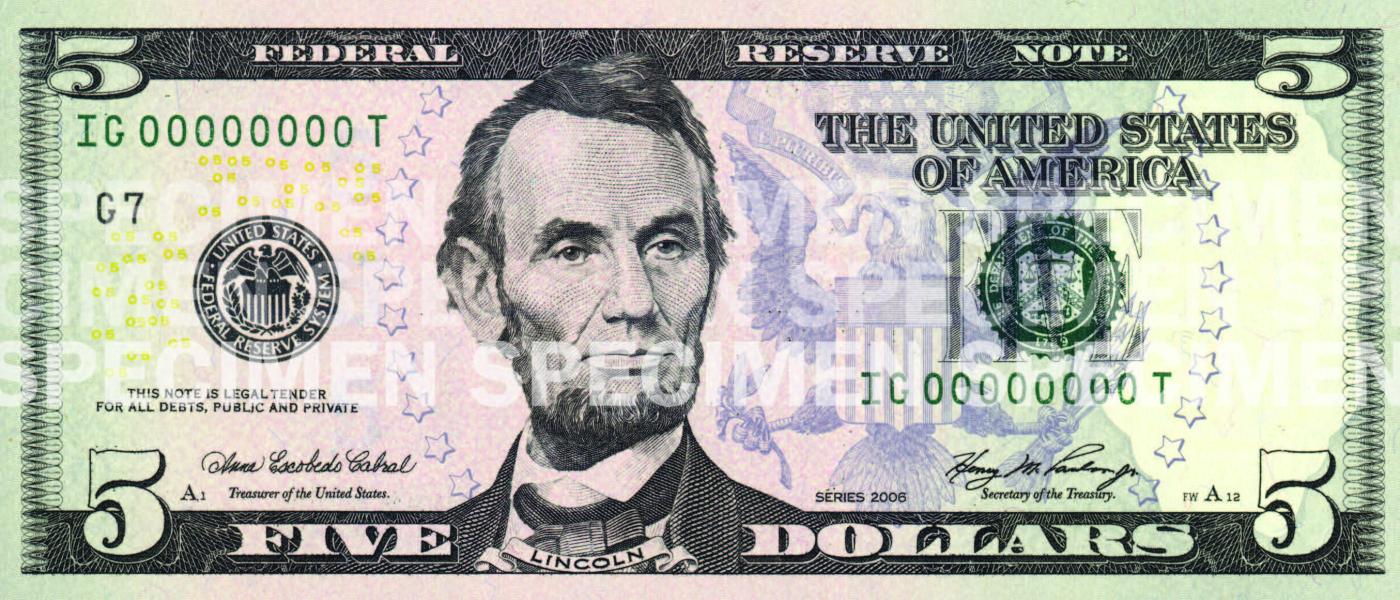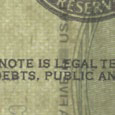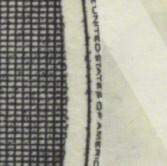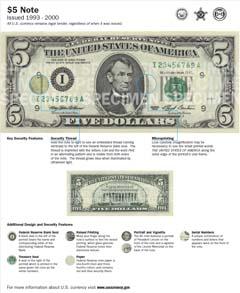Hold the note to light and look for a faint image of three numeral 5s to the left of the portrait. The image is visible from both sides of the note.
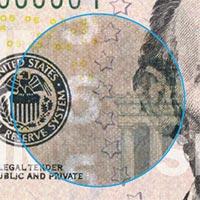
Hold the note to light to see an embedded thread running vertically to the right of the portrait. The thread is imprinted with the letters USA and the numeral 5 in an alternating pattern and is visible from both sides of the note. The thread glows blue when illuminated by ultraviolet light.

Hold the note to light and look for a faint image of a large numeral 5 in the blank space to the right of the portrait. The image is visible from both sides of the note.

Hold the note to light to see an embedded thread running vertically to the left of the portrait. The thread is imprinted with the text USA FIVE and a small flag in an alternating pattern and is visible from both sides of the note. The thread glows blue when illuminated by ultraviolet light.
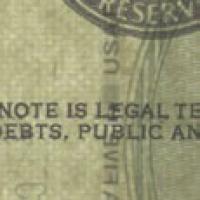
Hold the note to light and look for a faint image of President Lincoln in the blank space to the right of the portrait. The image is visible from both sides of the note.

Hold the note to light to see an embedded thread running vertically to the left of the Federal Reserve Bank seal. The thread is imprinted with the letters USA and the word FIVE in an alternating pattern and is visible from both sides of the note. The thread glows blue when illuminated by ultraviolet light.

Look carefully (magnification may be necessary) to see the small printed words THE UNITED STATES OF AMERICA along the outer edge of the portrait’s oval frame.

A black seal to the left of the portrait bears the name of the distributing Federal Reserve Bank.

Move your finger along the note’s surface to feel the raised printing, which gives genuine Federal Reserve notes their distinctive texture.
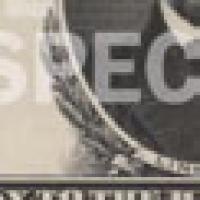
Federal Reserve note paper is one-fourth linen and three-fourths cotton, and contains red and blue security fibers.

The $5 note features a portrait of President Abraham Lincoln on the front of the note. The vignette on the back of the note changed in 1929 to feature the Lincoln Memorial.
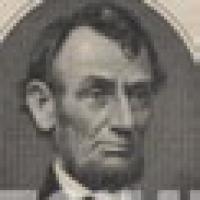
A seal to the right of the portrait represents the U.S. Department of the Treasury The design of the seal was changed to incorporate an English inscription and appears on all Federal Reserve notes of the 1969 series year or later.
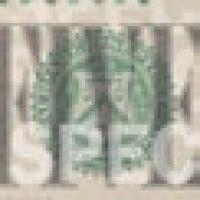

A black seal to the left of the portrait represents the entire Federal Reserve System. A letter and number beneath the left serial number identifies the distributing Federal Reserve Bank.

Look carefully (magnification may be necessary) to see the small printed text FIVE DOLLARS repeated inside the left and right borders of the note, E PLURIBUS UNUM at the top of the shield within the Great Seal, and USA repeated in between the columns of the shield. On the back of the note the text USA FIVE appears along one edge of the large purple numeral 5.

Move your finger along the note’s surface to feel the raised printing, which gives genuine Federal Reserve notes their distinctive texture.

Federal Reserve note paper is one-fourth linen and three-fourths cotton, and contains red and blue security fibers.

The center of the note is light purple, blending to gray near the edges.
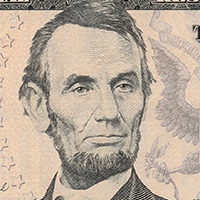
The $5 note features a portrait of President Lincoln on the front of the note and a vignette of the Lincoln Memorial on the back of the note.

The Great Seal of the United States, featuring an eagle and shield, is printed in purple to the right of the portrait of President Lincoln. An arc of purple stars surrounds the portrait and The Great Seal.
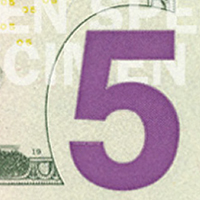
A large purple numeral 5 on the back of the note helps those with visual impairments distinguish the denomination.

A green seal to the right of the portrait represents the U.S. Department of the Treasury.

A unique combination of eleven numbers and letters appears twice on the front of the note.
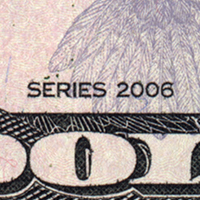
The design includes series years 2006, 2009, and 2013.

A black seal to the left of the portrait represents the entire Federal Reserve System. A letter and number beneath the left serial number identifies the distributing Federal Reserve Bank.

Look carefully (magnification may be necessary) to see the small printed words FIVE DOLLARS inside the left and right borders of the note and UNITED STATES OF AMERICA along the lower edge of the portrait’s oval frame.

Move your finger along the note’s surface to feel the raised printing, which gives genuine Federal Reserve notes their distinctive texture.

Federal Reserve note paper is one-fourth linen and three-fourths cotton, and contains red and blue security fibers.

A large green numeral 5 on the back of the note helps those with visual impairments distinguish the denomination.

A green seal to the right of the portrait represents the U.S. Department of the Treasury.

A unique combination of eleven numbers and letters appears twice on the front of the note.

A black seal to the left of the portrait bears the name and corresponding letter of the distributing Federal Reserve Bank.

A seal to the right of the portrait which is printed in the same green ink color as the serial numbers.

Move your finger along the note's surface to feel the raised printing, which gives genuine Federal Reserve notes their distinctive texture.

Federal Reserve note paper is one-fourth linen and three-fourths cotton, and contains red and blue security fibers.

The $5 note features a portrait of President Lincoln on the front of the note and a vignette of the Lincoln Memorial on the back of the note.

A unique combination of numbers and letters that appears twice on the front of the note.
The $5 note features subtle background colors of light purple and gray, and includes an embedded security thread that glows blue when illuminated by UV light. Two watermarks are featured in the $5 note, and they are visible from both sides of the note when held to light. Look for a vertical pattern of three numeral 5s to the left of the portrait and a large numeral 5 located in the blank space to the right of the portrait.

Downloads

Refer to this comprehensive guide for in-depth technical information on U.S. currency.

These printable coloring sheets of denominations $1, $2, $5, $10, $20, and $100 are intended for children, parents, and teachers.
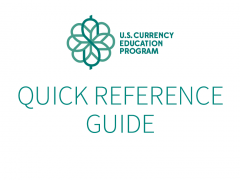
The Quick Reference Guide is a comprehensive resource on the security and design features of U.S. currency. This item unfolds and can be displayed next to a point of sale as an easy-to-use reference.

This 12-page booklet contains detailed information about the security and design features in the redesigned $100 note and those in the current-design $5, $10, $20, and $50 notes.
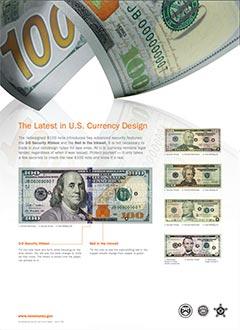
This poster features the security features in the redesigned $100 note and those in the current-design $5, $10, $20, and $50 notes.

This comprehensive guide includes technical information on the security and design features of the current-design $5, $10, $20, $50, and $100 notes.
